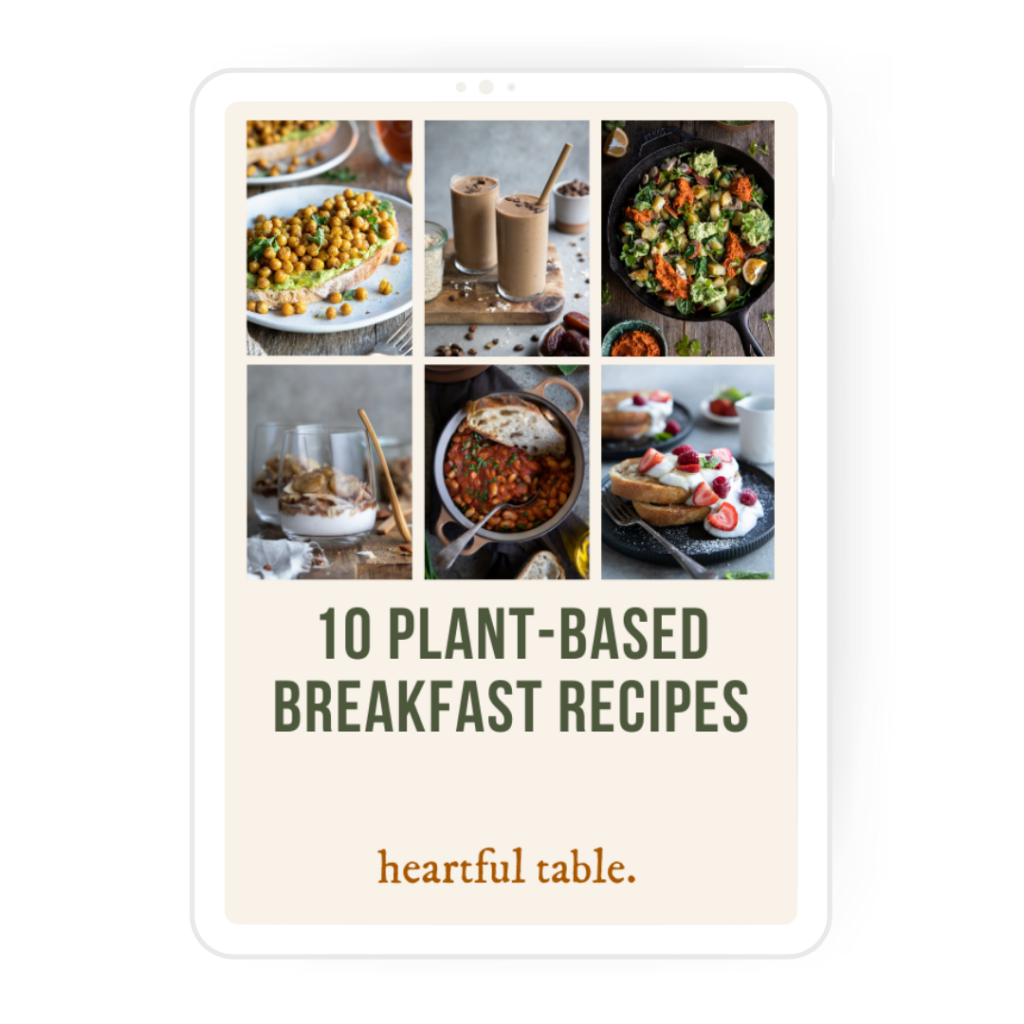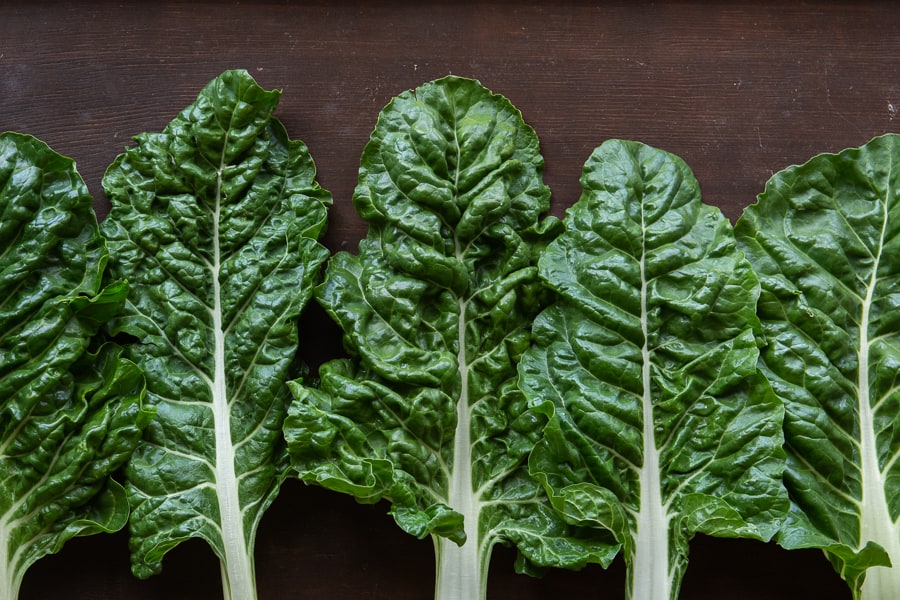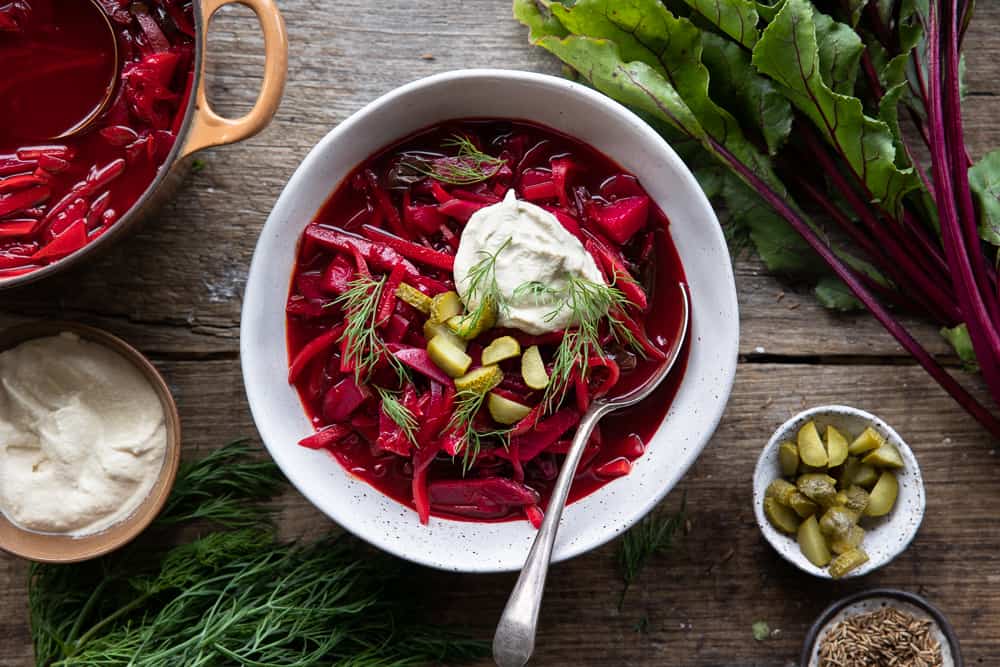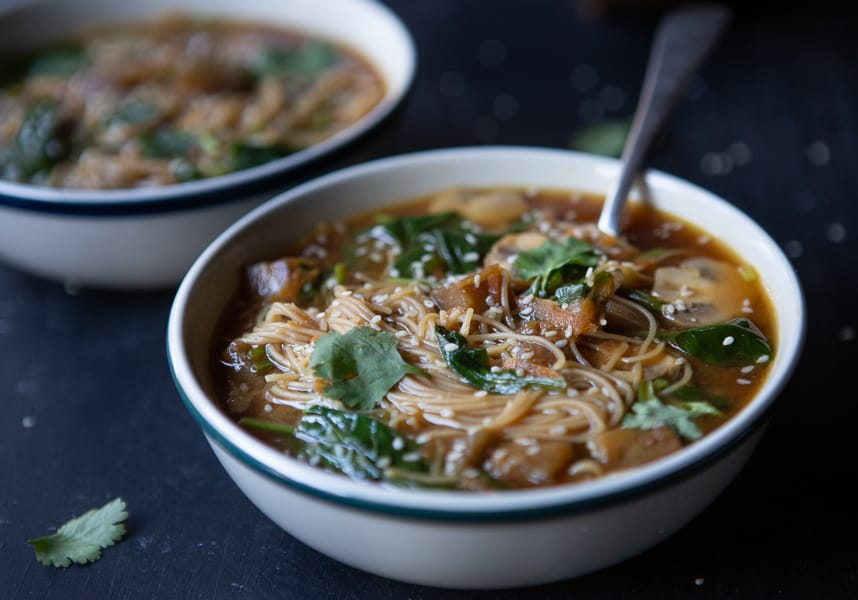Healthy Vegan Congee (Savoury Rice Porridge)
This healthy version of a vegan congee is the perfect filling savoury dish that you’ll fall in love with quickly. It’s the epitome of the simplest food, sometimes being the best food.
Congee, also known as jook, is a thick rice porridge popular in China and many other Asian countries as a breakfast dish. You can have it very plain or dress it up with a multitude of toppings. It’s really easy to customise, and can be enjoyed for breakfast, lunch, or dinner!
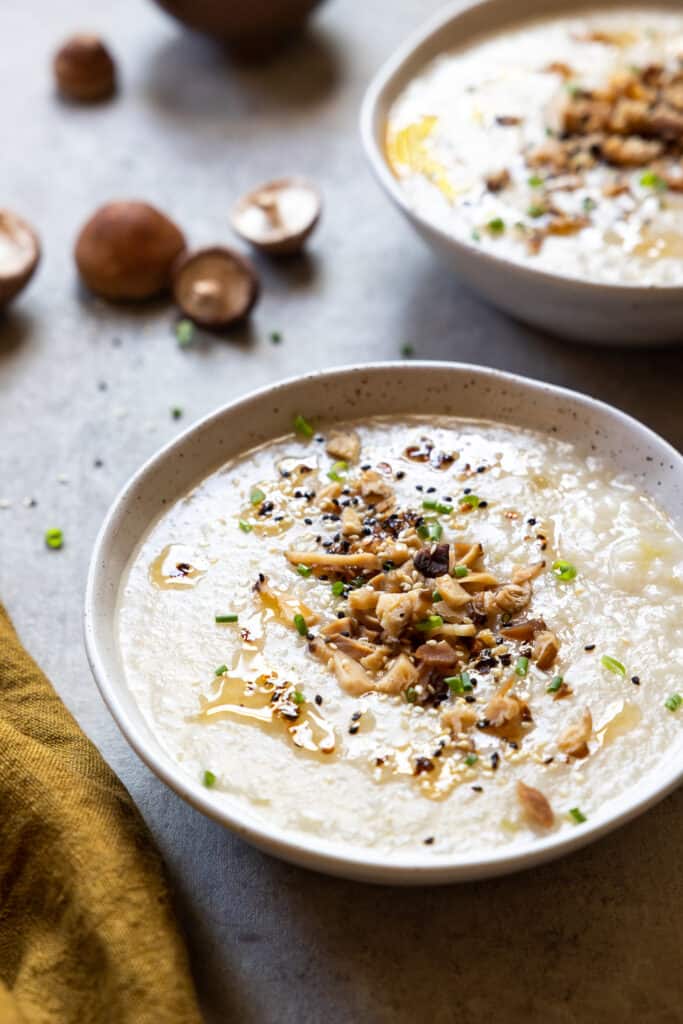
A healthy and nurturing dish that is often served to someone that is unwell, infants, and the elderly. The perfect comfort food that’s easy to digest and simple to make.
If you’re looking for a budget-friendly warm hug in a bowl, this dish is for you.
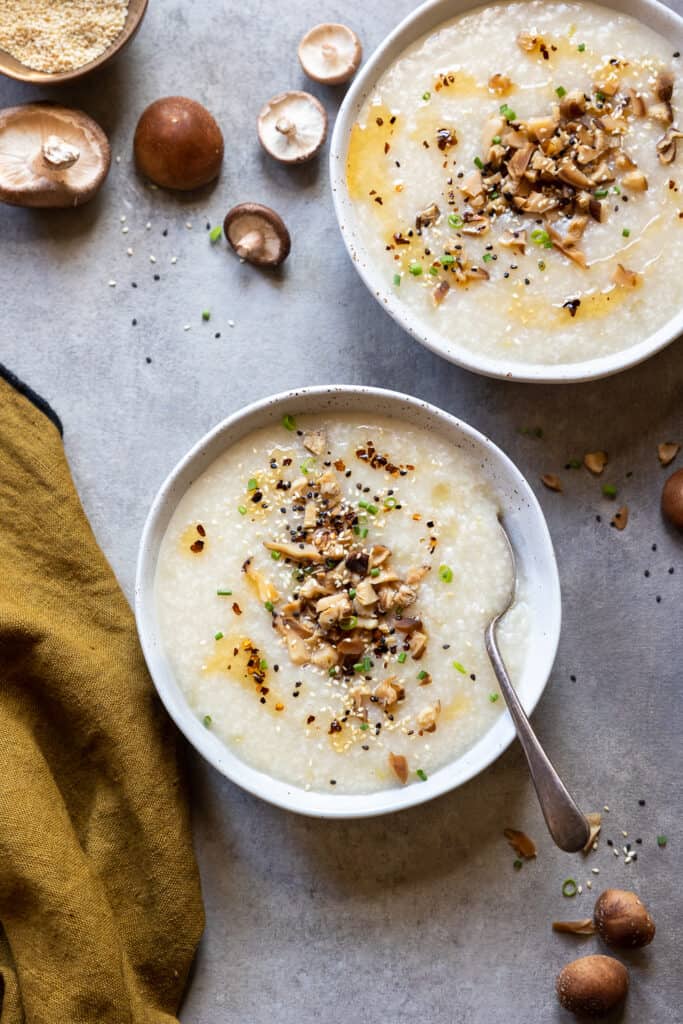
My connection to congee
I remember when I was younger, my mum used to make congee for me when I was unwell. It was my favourite meal to have in bed when I didn’t have an appetite and wanted something really plain but nourishing.
I didn’t know back then its roots and what it was called. It was just a meal that I knew my mum had been making for as long as I could remember, and I loved it.
Fast forward many years later, and now I see why I craved it so much and always welcomed it with open arms.
Looking at all the other possible variations out there, I think for an unwell person, I would still serve it the way that my mum made it. Because I believe, at its core, it is a meal that should be nourishing and use healthy ingredients.
If you want to make it fancy and add lots of toppings, be my guest, but this recipe, to me, is all about comfort and soothing ingredients. Something that you would also comfortably feed an infant and an elderly person (without the chilli oil).
I’ve made a hybrid between what my mum used to make and how I would make it for myself and others. It’s certainly not the ‘traditional’ approach to a Chinese congee, but an inspired version with my own twists.
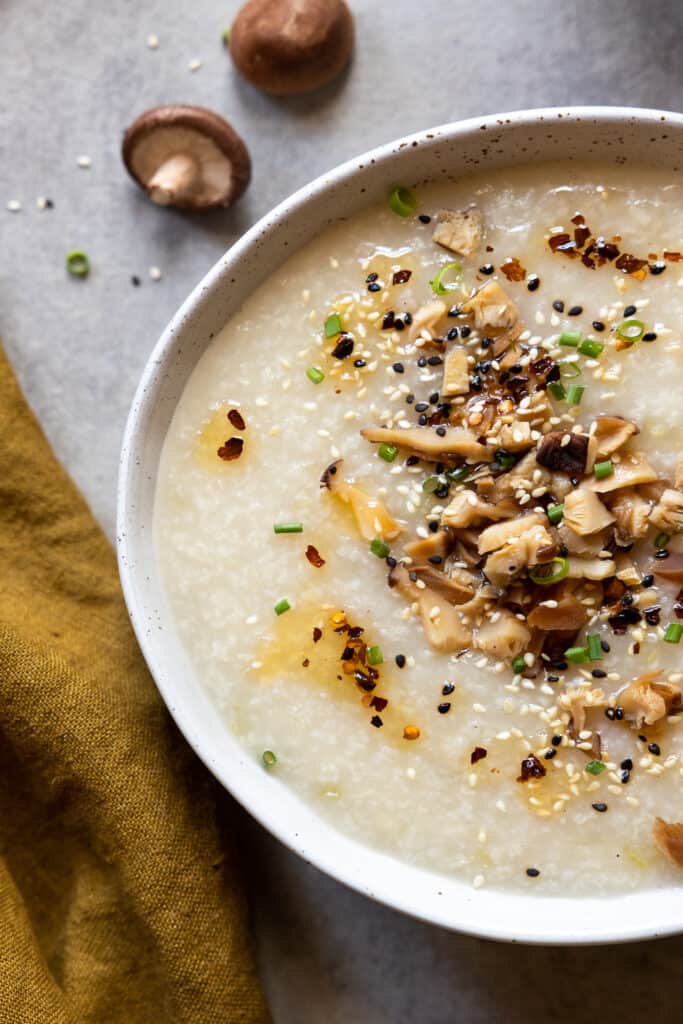
When do you usually eat congee?
Congee is typically enjoyed for breakfast as a warm easy-to-digest comforting dish but can also be eaten for lunch or dinner. A plain meal is often added as a side dish to accompany other dishes.
You can have it with steamed greens, proteins like tofu, or even legumes. I like it on its own, but play around and see what works for you.
It’s a great recipe for babies that begin eating solids as it’s a good transition food.
What’s in this vegan congee?
This congee is made of a simple base using:
- Spring onions
- Ginger
- Dried shiitake mushrooms (or dried mushrooms of choice)
- Chicken-style (vegan) or veggie stock
- Water
- Oil (can be made oil-free)
- Jasmine white rice
- Celery
- Black or white pepper (optional)
- Chilli oil (optional)
- Black and white sesame seeds (optional)
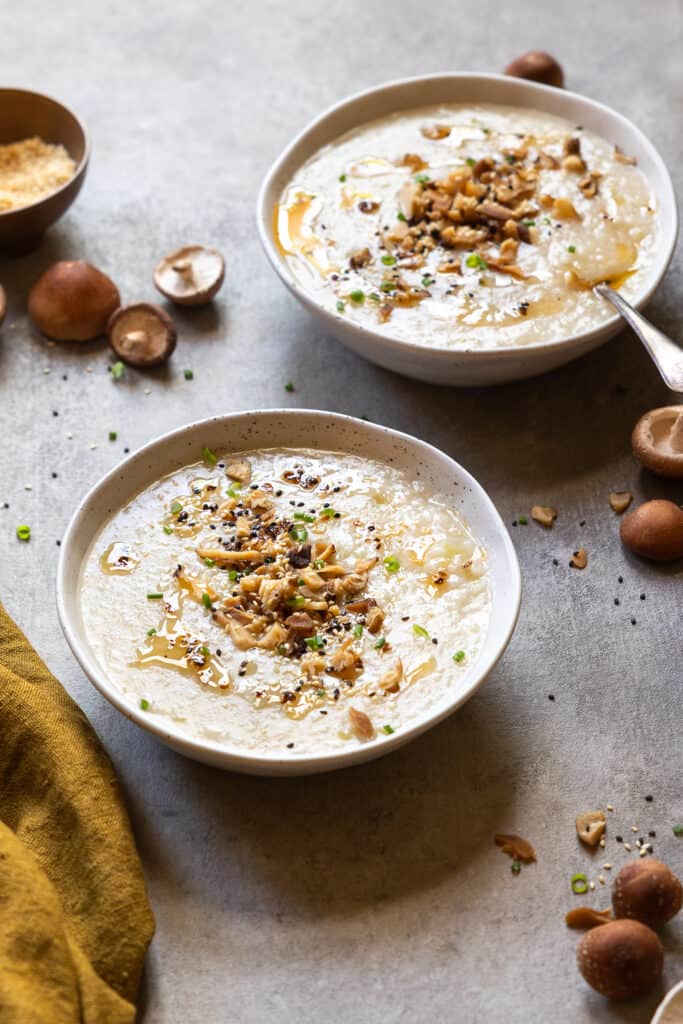
It’s all about the broth
Since congee is such a simple dish, it can be pretty bland, as I mentioned above. However, with the right broth and flavour combinations, you can make a potentially dull dish filled with flavour.
I find that using a mix of either homemade or storebought broth or stock combined with water and a few aromatics when cooking will make all the difference.
Many congee recipes use chicken stock that’s homemade by boiling a whole chicken and then using the sliced or shredded chicken meat as a topping. I wanted to use the same concept for the broth but make it vegan-friendly, of course.
These days many Chicken-style stocks on supermarket shelves don’t actually have any chicken in it. Go figure! I go for an organic stock that still has all the good stuff in it and will add the right umami to my rice porridge.
You can omit the Chicken-style stock if it’s not your thing or don’t have access to it. Just replace it with a good veggie-based stock, and you’re good to go. The stock will impact the overall flavour of your congee, so make sure it’s a good one.
This will also impact how much salt and seasoning are needed in the final product. I find that with the stock that I use, I don’t need extra salt, but you can adjust it to your palate when you taste it at the end. Alternately, use a light drizzle of tamari on top.
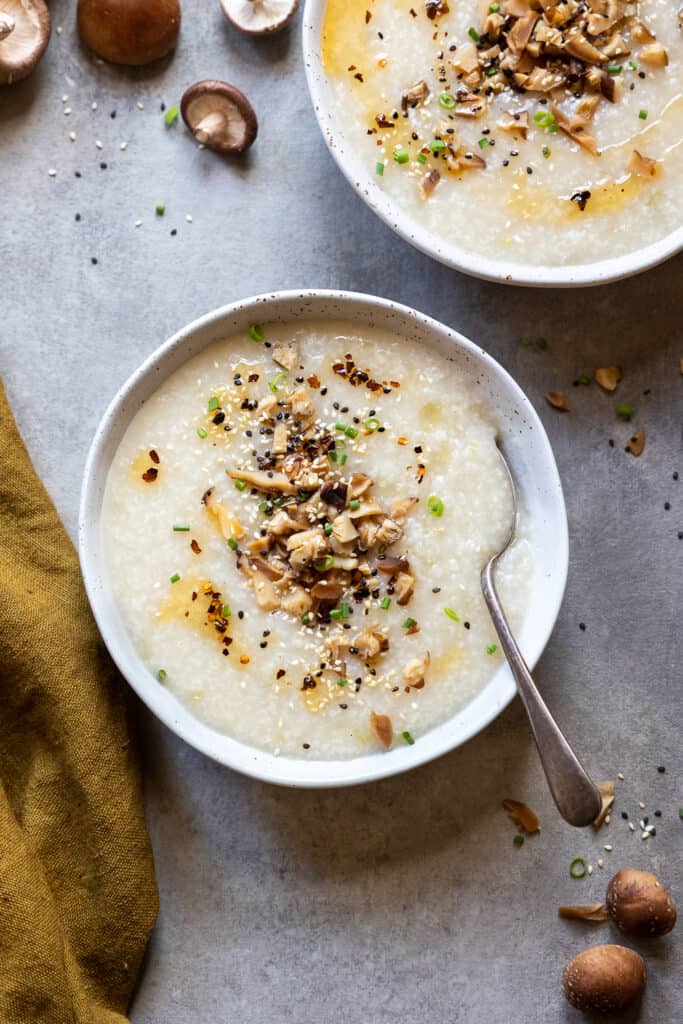
What other flavours work well with a vegan congee?
As I mentioned above, you can really pair it with whatever you like. Some other options for adding to the congee or toppings are:
- Fresh chillli, sliced
- Dried shallots
- Sesame oil
- Tamari or soy sauce (if the stock is low in sodium)
- Gomasio or furikake
- Bean sprouts
- Coriander / cilantro
- Fried tofu or my shredded tofu
- Kombu tsuyu or kombu dashi
- Shredded nori
- Daikon radish
- Parsley
- Chives
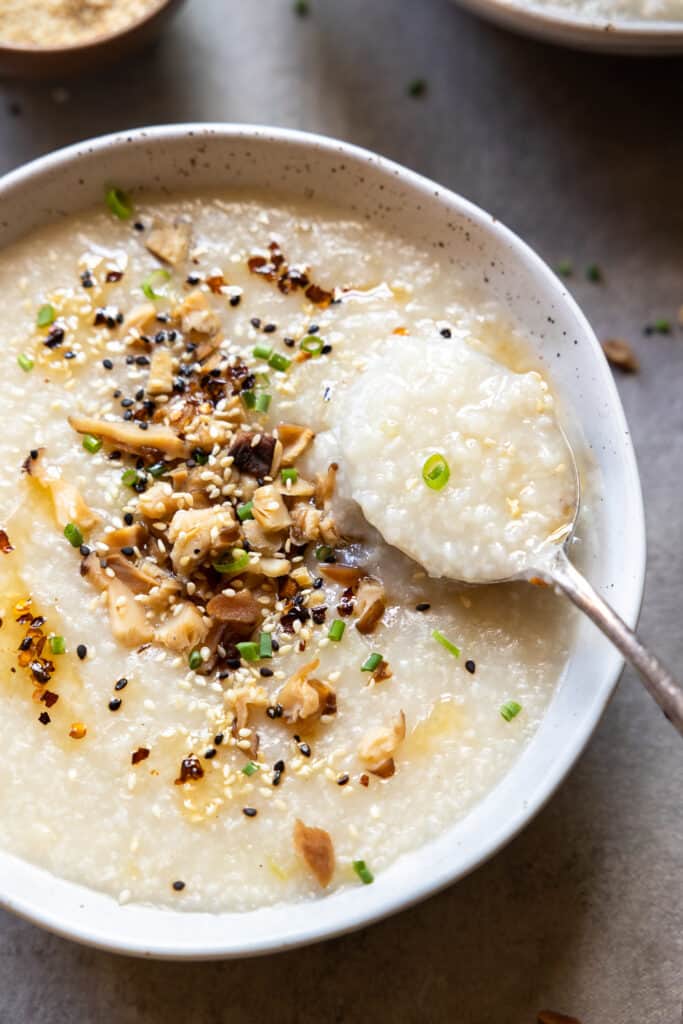
The best rice to use for congee
There are many recipes out there that use different types of rice, and it’s debatable which one is best. I find that using Jasmine rice is the most approachable variety and one most of us have on hand.
You can use either long or short-grain rice, it’s just about cooking it until you get the right consistency. A shorter grain of rice leans itself to be more starchy. I’ve tried it, and I personally found it a little too gluggy.
You’re essentially cooking it until it completely falls apart and disintegrates.
Congee can even be made using other grains like millet, barley, sorghum, quinoa, or brown rice. The cooking times will just vary depending on the grain you choose to use. Again, not a traditional method, but experiment and use the kind of grain that suits you.

Tips for getting the best results
- This rice porridge can be made very wet or thick. It really comes down to personal preference. I like mine in between. Thick enough that it’s not soup but thin enough that it melts in your mouth. To make it to the consistency you like, add or reduce the liquid content by about ½ a cup or cook it for longer.
- This is also a great way to use leftover rice. Simply add it in step just before adding the broth. You won’t have to cook it for as long, so reduce the water by about ½ a cup.
- You can add other vegetables when you saute the celery. Grated carrots, diced onions, minced garlic, and finely sliced daikon are a few options. You can also stir in some fresh greens like spinach, kale, and Asian greens at the end when you turn it off. If you’re using something like bok choy (aka pak choi), add the harder stems earlier in the cooking process.
- The water-to-rice ratio will vary depending on a few factors. The type of rice you use, how old it is, and your stove. Since it cooks for a while, these will all play a role in the end result. Play around and adjust it to your liking.
Other recipes you’ll love:
- Vegan Noodle Bowl (Gluten-Free)
- Summer Kelp Noodle Salad
- Mushroom & Eggplant Miso Soup with Brown Rice Noodles
- Vegan Laksa
- 30-Minute Vegan Buddha Bowls (Three Ways)
- 15-Minute Miso Glazed Eggplants (Vegan & Gluten-Free)
- Vegan Bún Chay Noodle Bowl (Vietnamese Noodle Salad)
If you try this recipe, let me know. We’d love for you to leave a comment and rating below. If you want to go that extra mile, tag us on Instagram or share your photo of the recipe on Pinterest.
Print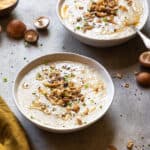
Healthy Vegan Congee (Savoury Rice Porridge)
- Prep Time: 10 minutes
- Resting Time: 20 minutes
- Cook Time: 1 hour 40 minutes
- Total Time: 2 hours 10 minutes
- Yield: 2 as a main
Description
Creamy, soothing, and healthy, this vegan congee recipe is perfect for when you’re feeling a little under the weather or are wanting a big bowl of goodness in the cooler months.
Ingredients
- 2½ cups / 625ml water
- 4 cups / 1 litre vegan chicken-style stock* (or veggie stock)
- 2 spring onions / scallions, roughly chopped
- Large knob fresh ginger, chopped (about 2-3 tablespoons)
- ½ cup / 8g dried shiitake mushrooms
- 1 tablespoon neutral oil
- 1 celery stalk, finely chopped (about ½ cup)
- ½ cup / 110g white Jasmine rice (wash first)
Toppings (optional)
- Shiitake mushrooms (from the broth)
- Chilli oil
- White or black pepper
- Spring onions / scallions, finely sliced
- Black and toasted white sesame seeds
Instructions
- To a medium-sized saucepan on medium-high heat, add the water, stock, spring onions, ginger, and mushrooms. Bring it to a gentle simmer, then reduce and cook for 30 minutes.
- When there are about 10 minutes left, take another similar-sized saucepan and put it on medium-high heat. Add the oil and celery and saute for about 5 minutes.
- Rinse the rice and add it to the pot as well. Mix for about 3-5 minutes until the rice starts to release a toasted aroma and starts to stick to the bottom of the pan a little.
- When the broth has finished cooking, strain it through a fine mesh sieve straight into the other pot with the celery and rice. Push down the veggies with the back of a spoon to strain all the liquid and set aside. Don’t discard!
- Stir well, lower the heat slightly, and cook for 1 hour on a gentle simmer, partly covered. Stir it occasionally.
- While that cooks, pick out the mushrooms from the strained veggies and chop them finely to use as topping for your congee and set aside.
- Keep an eye on the congee towards the end to see how thick or thin it is. You can increase or decrease the heat to adjust it to your liking. Just remember that it will thicken as it sits.
- Adjust the seasoning if needed. (If it needs more salt, you can also top it with some soy sauce or tamari.)
- Turn it off and let it sit covered for 20 minutes before serving with desired toppings.
Notes
Vegan chicken-style stock: There are many commercial brands that make a chicken-style stock that is vegan. Check the carton to confirm before buying. Normally one that is labeled as ‘style’ won’t have chicken in it. If you prefer, you can use a veggie-based one instead. I chose this one as it’s a little closer to a traditional type of congee.
Consistency of congee: It can be made very wet or thick. It really comes down to personal preference. I like mine in between. Thick enough that it’s not soup but thin enough that it melts in your mouth. To make it to the consistency you like, add or reduce the liquid content by about ½ a cup or cook it for longer.
- Diet: Vegan

